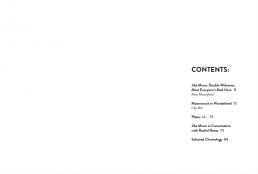Jiha Moon: Double Welcome, Most Everyone’s Mad Here Introductory Essay
Published by the Halsey Institute of Contemporary Art (2017). Hardcover with jacket.
Jiha Moon harvests cultural elements native to Korea, Japan, and China and then unites them with Western elements to investigate the multifaceted nature of our current global identity as influenced by popular culture, technology, racial perceptions, and folklore. In more than fifty compositions that appear both familiar and foreign simultaneously, the artist blurs the lines between Western and Eastern-identified iconography, depicting, for example, smartphone emojis and characters from the online game Angry Birds floating alongside Asian tigers and Indian gods.
Moon’s witty and ironic art explores how Westerners perceive other cultures and how people in those other cultures in turn perceive the West. Korean born, now living in Atlanta, Georgia, Moon asks the pertinent question, “Why do people love foreign stuff so much? When we travel to other countries, explore different cultures, and meet with new people, we tend to fall in love with things that are not our own. People have a soft spot for foreign things. The world is so interconnected nowadays, how can you even tell where someone or something ‘comes from’ anymore?” In her work, Moon acts in the role of a traveler, exploring the notion that identity is not beholden to geographic location.
Honoring traditional Asian arts through her use of Hanji, Korean silk, and calligraphic brushstrokes, she plays with iconography and symbols that have been classified as “foreign,” such as blue willow china patterns (developed in England, inspired by Chinese export ware), fortune cookies (which originated in California but are identified as Chinese), Korean fans, and floating dragons, and intermingles them with references to pop art and Southern folk art. Her use of the peach, identified in Chinese mythology as a symbol of immortality, is also in homage to her adopted state of Georgia, whose signature fruit is the peach. Moon transforms a traditional Korean fashion accessory called norigae into endearing quirky manifestations of various personalities with names like Gloria and Rachel whose hair is interwoven with eclectic items such as children’s plastic barrettes or Native American beaded dolls. Her misshapen and whimsical ceramics reference Southern folk art face jugs yet are made using traditional Asian ceramic glazes and motifs. At the heart of this recent body of work, Moon presents an installation featuring stereotypical elements of Asian home decor: low wooden tables and embroidered silk pillows placed on Japanese tatami mats. Displayed on the various surfaces are her unconventional ceramic works, reflecting her interest in the “beautiful awkward,” her description of tourists’ desire to collect foreign and exotic elements to beautify their houses back home.
At first glance, Jiha Moon’s work appears as a mashup of high and low brow cultural allusions. Upon further inspection, slyly ironic and humorous references satirically filtered by the artist become evident, reminding us that our preconceived notion of “others” is not a true manifestation of actual identity.
Amy Moorefield
Deputy Director of Exhibitions and Collections
Taubman Museum of Art


